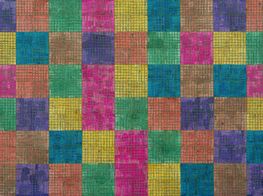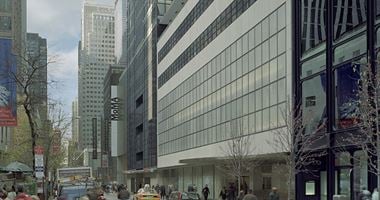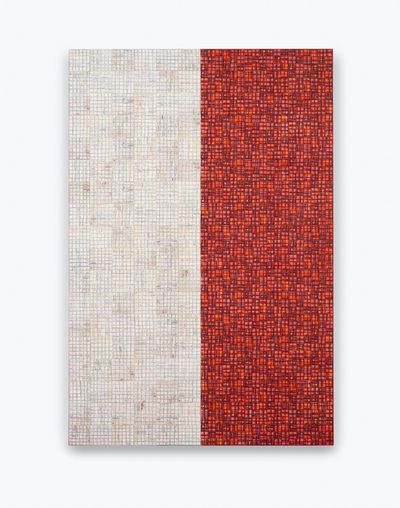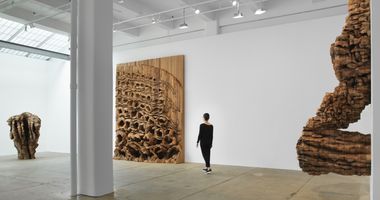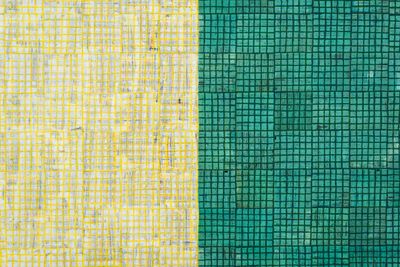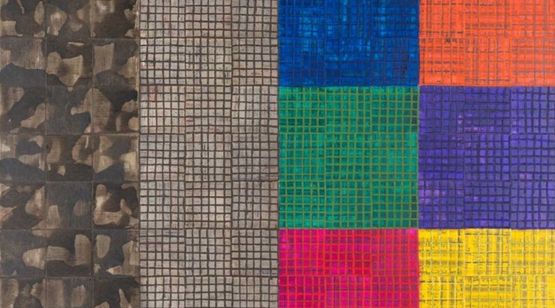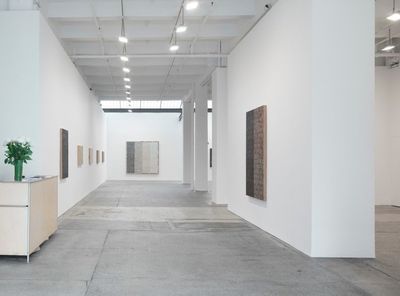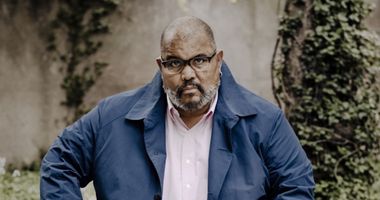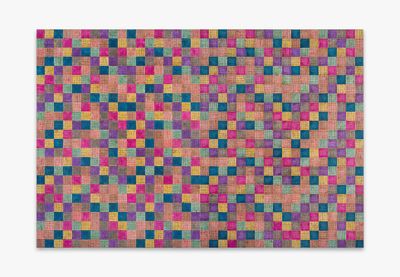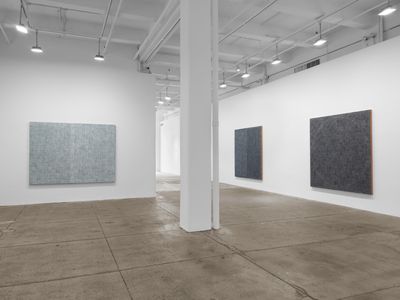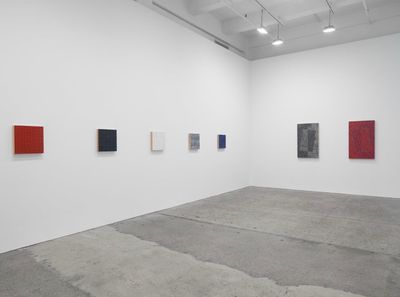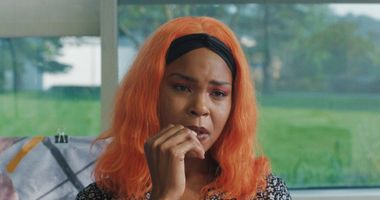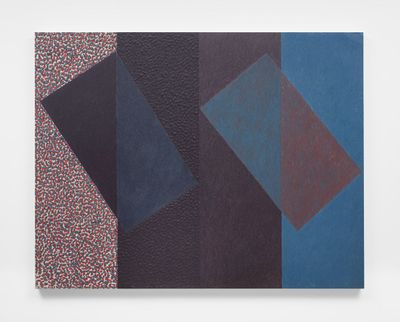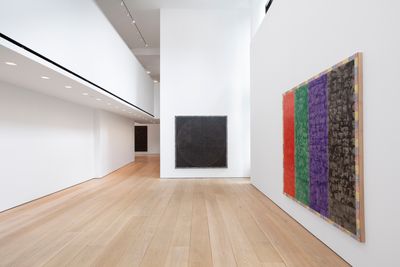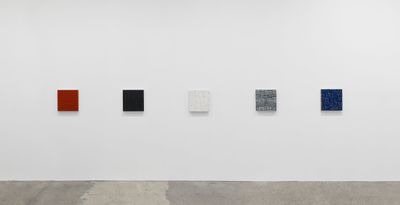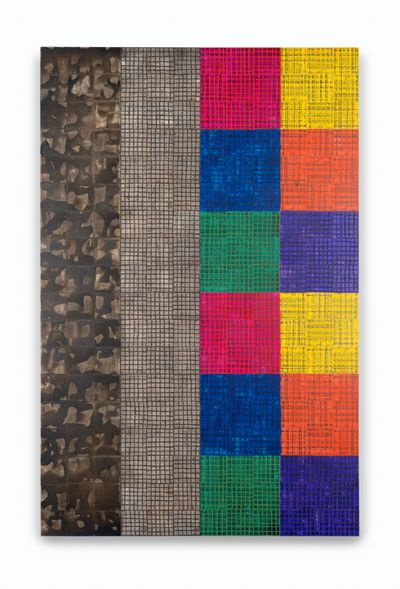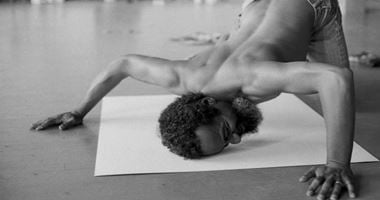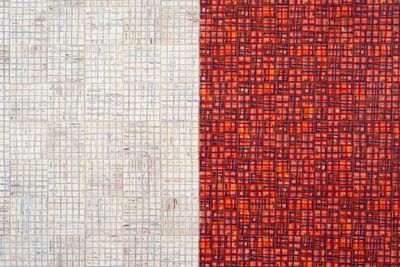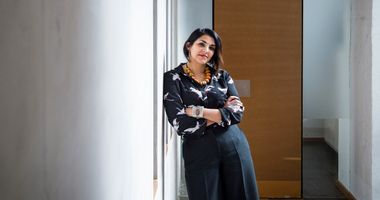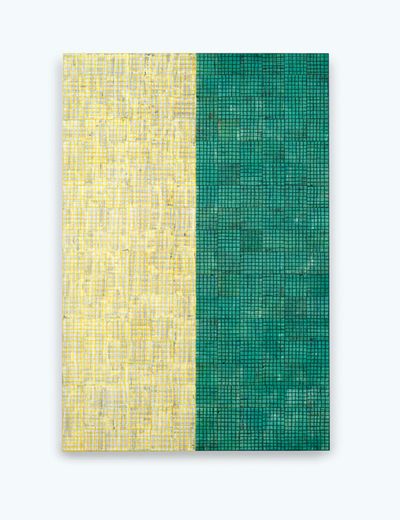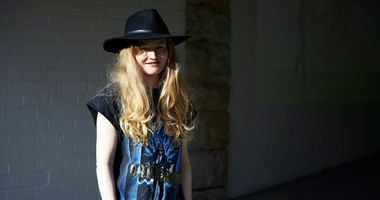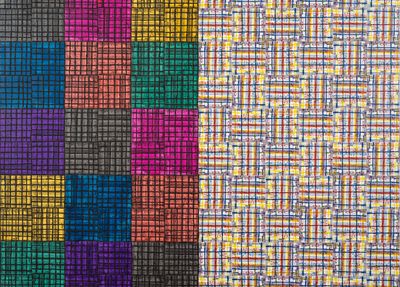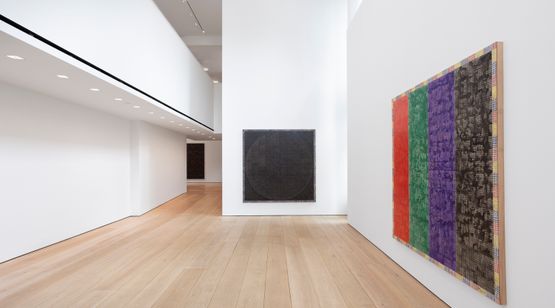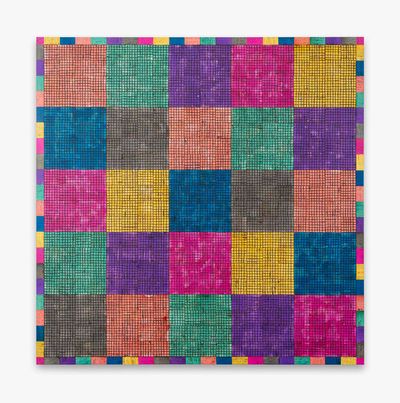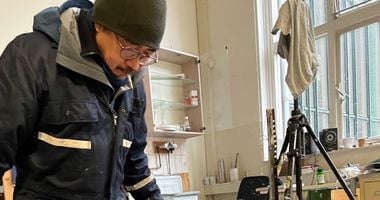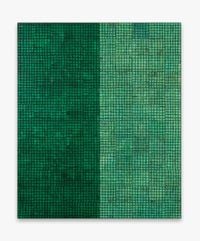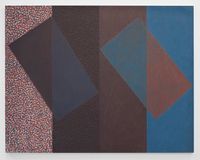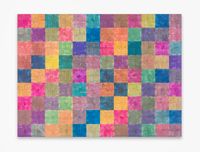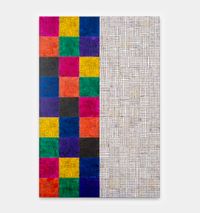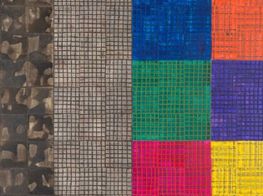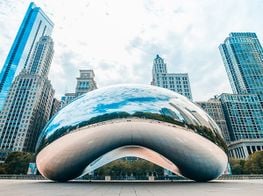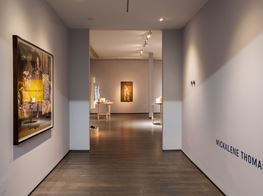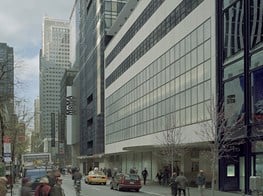McArthur Binion: 'I didn't come from art history, I landed there'
McArthur Binion (2021). Photo: William Jess Laird.
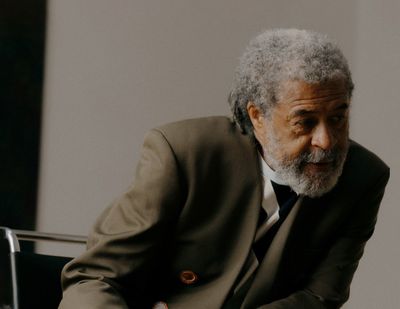
McArthur Binion (2021). Photo: William Jess Laird.
Born one of 11 children to sharecroppers in Mississippi, United States, in 1946, McArthur Binion grew up in a small house with a large family who migrated to Detroit in 1951 for his father's new job in Motor City's burgeoning auto industry.
Despite the hardship of his childhood, Binion strived in secondary school and college and 'made himself up'—as he describes—on his journey to becoming an artist across Detroit, New York, and Chicago over a 40-year period.
Landing a job as an associate editor at a publication in New York's legendary Harlem neighbourhood after graduating high school, Binion saw his first painting while delivering a letter to the Museum of Modern Art, which made a huge impact on him.
Binion took drawing classes and moved back to Detroit and Michigan to get his college degrees, before relocating to New York's developing SoHo creative community in 1973. Attaining a loft, a teaching job, and an exhibition within two months of his return, Binion was on his way.
Being a Black artist in New York's mostly white commercial art world made achieving artistic success difficult in the 1970s and 80s. That said, Binion embraced the bohemian life by giving up teaching for jobs in construction and taxi driving to have more time to experiment as a painter.
A natural-born hustler, Binion found inventive ways to survive as he moved from studio to studio in SoHo, Tribeca, and Chelsea, until the increased cost of living in New York and a romantic courtship caused him to leave his large network of friends behind and move to Chicago in the early 1990s.
Settling into the Windy City, the artist dedicated himself to teaching at Columbia College and raising a family, putting his art on the back burner for the first time. After obtaining tenure as a professor, Binion took a leave of absence in Lisbon, where he made works to kickstart his art career again.
A solo show at Contemporary Arts Museum Houston in 2012 brought accolades but no sales, which made the artist realise that he needed to start showing at galleries to increase his recognition and put his children through college.
After a false start, a recommendation brought Chicago gallerist Kavi Gupta to his studio. Solo exhibitions with the gallery followed with more one-person shows with Galerie Lelong in New York—Re:Mine (2015) and Route One: Box Two (2017), as well as Massimo De Carlo in London and Milan.
Binion then alighted at Lehmann Maupin, where he has had multiple solo shows at its New York, Hong Kong, and Seoul locations. Among them, DNA:Study/(Visual:Ear) will be opening at the Seoul gallery from 1 September to 22 October 2022.
Ocula Magazine recently spoke with the artist in his Chicago studio to discuss his humble beginnings, adventurous development, rise in recognition, lively paintings, and the thrill of success, which the industrious artist credits to a lifetime of friendly social interactions and hard work.
With this second solo show in Seoul and upcoming one-person exhibitions at Xavier Hufkens in Brussels, Massimo De Carlo in London, and Gray in Chicago, McArthur Binion has built a legacy that is here to stay.
PLYou refer to yourself as a 'rural modernist', yet you were raised in Detroit and have only lived and worked in big cities like New York and Chicago for most of your life. What are the roots for this tag and how have these roots helped define your artwork?
MBI didn't come from art history, I landed there. I had been born on a farm in Mississippi; my mindset is still rural. I never learned nor did I want to learn the ABCs of making art and was never interested in Rembrandt. When I transferred my major from creative writing to art, my head was already there. I just had to find my hand.
PLWhat did you retain from studying art in college?
MBOne of the most important things I learned from my father and my professors in art school is the value of hard work. Being smart isn't special anymore—it's the easy part now. The hardest part is coming up with an interesting idea and to pursue it. To develop an idea fully, you work it down to the bone, as hard as you can—sop it up.
PLYou lived and worked in New York as a writer and editor before college but came back to live and work in SoHo as an artist in 1973, and later, Tribeca and Chelsea. What was the New York art scene like at that time?
MBIt was amazing, man. First, there wasn't anything called the art world yet, that came in the late 1970s or early 80s. When I moved to SoHo in 1973, it was like a small community, where everyone knew one another.
I wanted to come from a different place historically and first abandoned the paintbrush because I wanted to break the rules.
If you stood on the corner of West Broadway and Spring Street for a couple of hours, you would see everybody in the entire 'art world' pass by. The older established artists would make themselves available to younger artists; they came into our studios to look at our work.
I arrived with a tenured teaching position at Ramapo College of New Jersey and was able to rent a loft and begin working in the studio as a serious professional within 60 days. I had my first show—a three-person exhibition—at Artists Space in Tribeca in November 1973.
The artists who organised the show—Carl Andre, Sol LeWitt, and Ronnie (Ronald) Bladen—made sure they invited other artists from the community to meet us. I met a lot of major artists, both Black and white, very early on.
At the opening, a guy came up to me and after looking at my work, he said, 'See you in ten years.' I said, okay, and then I asked, 'Who was that guy?' Someone said, 'Jack Whitten'. I learned there and then that you had to earn the right to call yourself a painter. You had to work hard and fight, which I think is a brilliant idea.
Ten years after graduating from art school, only five to ten percent of students are still making art. The fact that I could be a full-time artist with a part-time job was amazing; the economy hadn't gone nuts yet, so it won't be happening again.
PLDid you see yourself as an abstract, minimalist painter working in a grid format, or did you define your work in other, more personal terms?
MBI've never seen it as making grids. I see it as making shapes, which is how I've always lived. Living in a two-bedroom house with a lot of people, you learn a sense of order. We lived that way successfully, without being overly regimented. But I've always liked order.
PLIn previous interviews, you've often said 'I made myself up.' What do you mean by that?
MBI made myself without mentors or anything to follow. I wanted to come from a different place historically and first abandoned the paintbrush because I wanted to break the rules. I was born in a house with no bathroom nor water for nine children and two parents. There wasn't any music or books or anything like that, so it was like I made myself up.
We're losing the hand, which I think is very important, but a lot of artists don't use it.
The summer I worked in New York as an associate editor of a magazine, I was basically an errand boy for the editor. One day she sent me to deliver a letter to the Museum of Modern Art, which was the first time I'd ever been to a museum. I saw a painting for the very first time, but being a poet and a writer, I saw it as a philosophical gesture. It took me two years to build up the nerve to take my first drawing class.
PLYou taught art for a couple of years while you were in New York, but how did you survive nearly 20 years without regular gallery representation?
MBI'm a natural-born hustler. I learned to be super social and super cool at an early age. I hung out on the streets and skipped school for the first time when I was seven years old. I learned early on as an artist that if someone likes me, they're also going to like my work. It was like, boom!
I didn't come from art history, I landed there.
So twice a year, I would get on the aeroplane with a couple of portfolios and go to cities in the Midwest, like Detroit or Cincinnati, and take house calls. I found collectors who weren't fond of galleries but liked art. They loved it when I brought art to their houses. I went to dozens and dozens of houses with my portfolio and never once left without a check.
PLHow did your world change when you moved to Chicago in 1991?
MBI moved to Chicago because I was seeing someone I met in Detroit when I had a big show there in 1990. She had moved there and I didn't want to lose this relationship; I didn't have a good history with long relationships.
Before I left New York, I sold enough work to move to Chicago and keep me going for a year because Chicago was much cheaper. We got married, I wanted to be a good husband and father, so for the first time in my career, I put my work last. My family came first.
I got a job right away teaching at Columbia College and established a strong relationship with the administration so that I only had to teach classes—no committees, or any other work. As a result, I was able to establish my studio practice and have a full-time job.
I was able to further the work that I had begun developing in Tribeca in 1974 and 1975. I learned to exist on five hours of sleep for years, it's a habit now. An advantage of not having a gallery is that there was never the pressure to show. I was always secure in my knowledge and talent as an artist, so I didn't feel like I needed to show a lot.
PLWere you more interested in continuing to experiment?
MBI wanted to make a difference in the world for Black painters. It started with the Cuban artist Wifredo Lam. I was fascinated with him and he became my model. When Lam moved to Paris, Picasso embraced him, and he became influential to many well-known artists. Three years ago, I was able to buy a Wifredo Lam painting, which is one of the most amazing moments in my life.
PLAfter teaching in Chicago for some years, you took a sabbatical to make work full-time in Lisbon. Did that help restart your art career and reinstate interest in your work?
MBYes. When I put my work last, I got tenure after six years. When I went to Lisbon, I became an artist again. Man—every time I think of it, I start to cry. It's like I have an emotional, romantic relationship with Lisbon.
I go there at least once a year and stay in the same hotel. It's an amazing hotel with just six rooms, each with a big bathtub carved out of a solid piece of rose quartz. I'm a big bathtub guy, so I basically live in the tub half the day.
PLHow did your 2012 solo show at Contemporary Arts Museum in Houston generate gallery interest in your work?
MBIt did not. I had a very comfortable life in Chicago—a great teaching job and I was selling work. I had a nice house, kids in private school, the whole thing. But I realised that my two children were really smart and they were headed to good, expensive colleges and I should have a gallery to make more money.
The work had always spoken for itself, and galleries and collectors found out about it by word of mouth.
Then Valerie Cassel Oliver came into the studio and invited me to do the show in Houston. It was hugely successful and well-received, but nothing sold. I was like, fuck, what? After that, I came back to Chicago, and said, okay, I know I've got to get a gallery now.
I made a list of Chicago galleries to consider, but then Rashid Johnson, one of my former students at Columbia College, introduced me to his Chicago art dealer, Monique Meloche. I invited Monique and her husband to my studio—something that I had never done in my entire career.
The work had always spoken for itself, and galleries and collectors found out about it by word of mouth. I made an appointment with them and after agreeing to visit, they cancelled twice. I said, fuck galleries. I ain't calling another fucking gallery again.
At the bottom of my list of seven Chicago galleries was Kavi Gupta, a gallery with a lot of hot, young artists. The very next week, I get a call from him saying that he had heard about my work and wanted to come to my studio. On the day of his visit, he said something that touched me deeply before he left. He said, 'I'm going to put you in a place where you belong.' He was young and knew how to make money. Bam!
PLThe renewed interest in your work came when you started the 'DNA' painting series, around 2013. What does 'DNA' reference and how are these paintings unique?
MBI started to develop the idea eight or ten years earlier. I made six works on paper initially called self-portraits because they included images of pages from my phone book. I'd had the same address phone book from 1972 until I moved to Chicago in 1991. The last person in that book is Kerry James Marshall. My entire social D.N.A. was there.
In the 1970s, you communicated with people in three ways: eye to eye, through the telephone, or by mail. It was all about your phone book, or if you were a big-time business person, your Rolodex. Every person I'd ever met, sold to, slept with, or dated, were all in the same book.
I was a very social person. Everyone, from James Baldwin to Brice Marden, Jean-Michel Basquiat, and David Hammons, was in the book. But what D.N.A. meant to me from the very start was 'Detroit Negro Artist'. You're probably the second person I've ever told that to, and that's how it started. I'm in for the race.
How did abstract-expressionist painters move from basic Cubism to pure abstraction so fast? Any idea?
PLSure, because of the European artists who came to New York during World War II.
MBIf you look at it spiritually and in an unbiased way, they went to jazz clubs and listened to bebop artists and learned to improvise abstractly. No one talks about it because if that becomes true, you have to reprioritise the order and Black artists become much more important. My work starts at that introduction.
PLSo you were working experimentally, improvising?
MBAbsolutely. That's why you have to make yourself up. You know all the ingredients, therefore you can repeat it—and it's necessary to be able to repeat because then you understand its D.N.A.
PLAnd then you can vary it.
MBExactly, and then sell it. And then you can help other younger Black artists that you want to leave a map for. You dig?
PLYou create these paintings in a silent studio so that nothing is coming in—it's all going out, from you to the work. How does this impact your process and the final piece?
MBI don't have an overview of the process, but in terms of how the world outside has responded to the work, it's right on point. I want to be able to find out who I am by myself, without the aid of other things.
I have nothing against friends who have people making their art. But it's like, where's the D.N.A., baby?
The only musicians I've listened to in the last ten years are personal friends of mine who have passed away. When my great friend and the godfather of my oldest daughter, Cecil Taylor, passed, I listened to his music for an entire day. I did the same thing for Ornette Coleman, Butch Morris, and others.
PLDo you make your work by yourself, or do you have assistants that paint alongside you?
MBAll by myself. We're losing the hand, which I think is very important, but a lot of artists don't use it. And I have nothing against friends who have people making their art. But it's like, where's the D.N.A., baby? You have all these foreign hands on the work? Sorry, not me. I develop the next work while I'm painting the present one.
PLKnowing that each body of work is influenced by the previous one, what are the new elements at play in your paintings at Lehmann Maupin in Seoul?
MBColour. I carried over the theme from my last show at the gallery in 2021, which was titled Modern:Ancient:Brown.
PLAre you playing with the colours in another way?
MBOh yeah, totally.
PLAt Lehmann Maupin, you're showing the 'DNA' paintings, which we have discussed, and paintings from the 'Visual:Ear' series (2022). What's the 'Visual:Ear' series about?
MBThe 'Visual:Ear' paintings contain the visual elements from a music scoring. The music score comes from a composition called 'Stuttering Standing Still', which I commissioned my friend Henry Threadgill to write.
Once he completed it, I took the black and white of the music score and turned it into a red, yellow, and blue etching, and painted on top of that with red, yellow, and blue oil sticks. I used the etching as a ground to paint upon, or what I call the 'underconscious'.
PLHow did you come up with the colour combinations?
MBInstinct. I work instinctively and live instinctively.
PLHow do you feel about showing new paintings in Seoul?
MBI'm excited. I hear there's a lot of interest in the work there. This is my second show in Seoul with the gallery. People identify with my work there and how it's made. You can look at my work and see the labour.
PLDo you have any regrets that it took so long to get to this point, where you're able to make the art you want and have it shown around the world?
MBAbsolutely not, I think it happened at the best time in my life. Had it happened earlier, I would've blown it. Guaranteed.
PLArman once told me that you have to be a candidate in time. When the time taps you on the shoulder, when it's your turn, you have to be prepared.
MBI was ready, baby.
PLAnd now you are making yourself available to younger artists through your residency in Detroit. Is this your way of sharing your success and giving back?
MBNow that I'm making money, I want to lend support to young artists, so I established the Modern Ancient Brown Foundation to support artists from around the world to come for a residency in Detroit and Western Michigan. I plan to leave the foundation a great deal of work and money, so that it can make an impact for hundreds of years. —[O]

